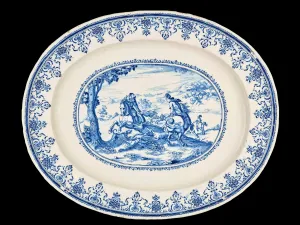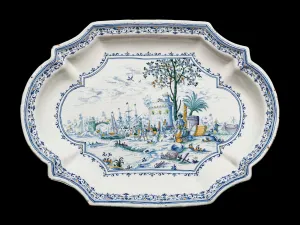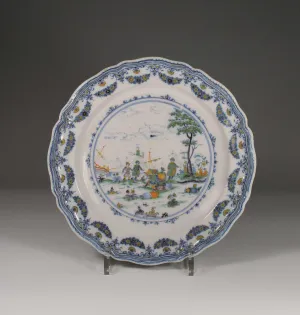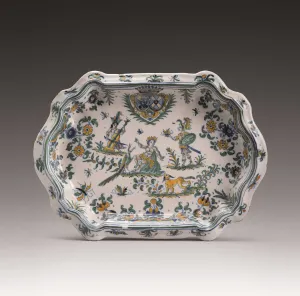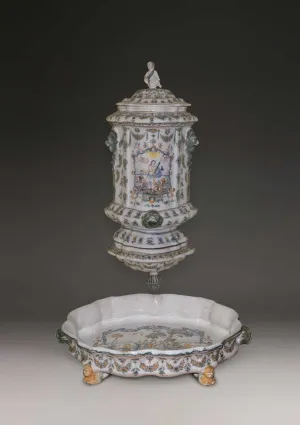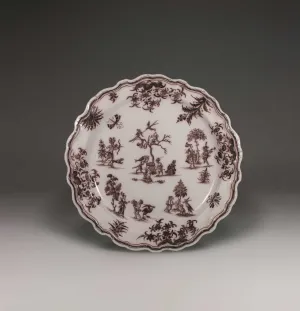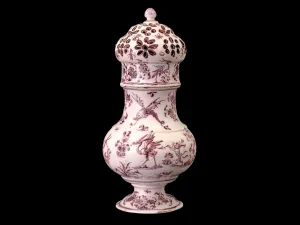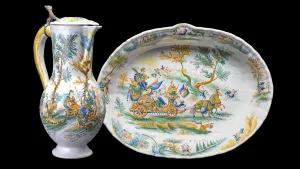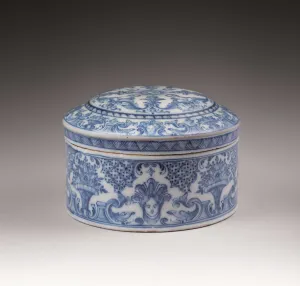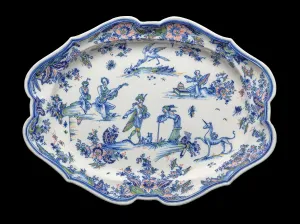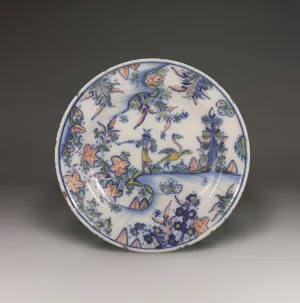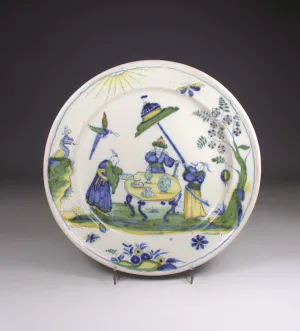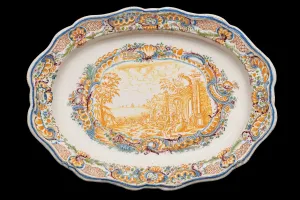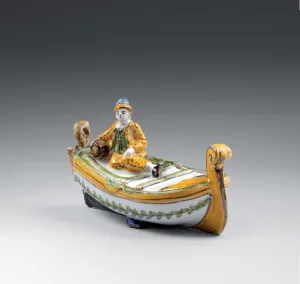The Expansion of French Faience to the South of France
In the late seventeenth century, the region of Provence emerged as a new, important center of faience production, with workshops opening in Moustiers and Marseille about the same time. About 1679, Pierre Clérissy opened the first faience manufactory in Moustiers (operated by the same family for three generations, until 1783); Pierre’s brother, Joseph Clérissy, opened the first faience manufactory in Saint-Jean-du-Désert, near Marseille.
The Clérissy Manufactory in Moustiers
The pieces here represent the production of the Clérissy manufactory in Moustiers during the first half of the eighteenth century. The earliest pieces were in monochrome blue, like the large platter painted with a boar hunt (cat. 49) and the ewer in the form of a helmet (cat. 50). However, the masterpiece of Moustiers faience in the Knafel Collection is undoubtedly the large platter, painted in monochrome blue with yellow highlights and touches of green, depicting a complex scene with Asian merchants and boats (cat. 51).
The Olérys and Laugier Manufactory in Moustiers
In Moustiers, several manufactories that opened during the first half of the eighteenth century presented strong competition for the Clérissy family, especially with the arrival of Joseph Olérys, a talented potter from Marseille. Olérys worked in his hometown for three years beginning in 1723, before being recruited by the Count of Aranda to direct his new faience manufactory in the Spanish town of Alcora, near Valencia. In 1738, Olérys opened his own manufactory in Moustiers with his brother-in-law, Jean-Baptiste Laugier, whence the various marks combining O and L found on pieces from the manufactory (cats. 55, 56, 57, 59).
Joseph Olérys is probably the inventor of the most celebrated type of decoration found on Moustiers faience, characterized by asymmetrical compositions of small and fanciful figures, or grotesques, painted with a lightness of touch and yet great precision, in monochrome manganese or polychromy (cats. 54, 56, 57, 58, 59).
Marseille
The development of faience production in Marseille is closely related to that in Moustiers. The two centers were only about eighty miles apart, and many faienciers working at Marseille were from Moustiers. As a result, attribution of unmarked pieces can be quite challenging (for example, cat. 66). But Marseille manufactories also developed their own styles. The Leroy manufactory created a kind of flower that looks like a starfish, always painted in red, as seen around the borders of the large platter (cat. 63). And the Fauchier manufactory is celebrated for its “Don Quixote” services — with scenes from the famous Spanish novel by Cervantes painted in monochrome yellow (ochre), surrounded by rococo borders composed of asymmetric lines, shells, and latticework — represented here by a platter painted with an aristocratic couple and other characters near the ruins of an old castle or temple (cat. 67).
Platter
Moustiers, ca. 1700−20
Clérissy manufactory
Faience (tin-glazed earthenware)
H. 20 in. (50.8 cm), W. 24 3/4 in. (63 cm)
Cat. 49
© Christophe Perlès
Ewer
Moustiers, ca. 1700−25
Clérissy manufactory
Faience (tin-glazed earthenware)
H. 10 3/8 in. (26.5 cm), W. 9 1/2 (24.1 cm)
Cat. 50
© Christophe Perlès
Platter
Moustiers, ca. 1730−40
Clérissy manufactory
Faience (tin-glazed earthenware)
H. 12 1/4 in. (31.1 cm), W. 16 7/8 in. (43 cm)
Cat. 51
© The Frick Collection
Plate
Moustiers, ca. 1730−40
Clérissy manufactory
Faience (tin-glazed earthenware)
Diam. 9 7/8 in. (25.2 cm)
Cat. 52
© Christophe Perlès
Bowl on Foot
Moustiers, ca. 1740
Clérissy manufactory
Faience (tin-glazed earthenware)
Diam. 10 3/4 in. (27.3 cm)
Cat. 53
© Christophe Perlès
Tray with Coat-of-Arms of the Deschamps and Constant Families
Moustiers, ca. 1750
Clérissy manufactory
Faience (tin-glazed earthenware)
H. 7 in. (17.8 cm), W. 9 5/8 in. (24.5 cm)
Cat. 54
© Beylard, Ferrier and Lewandowski
Wall Fountain with Basin
Moustiers, ca. 1750
Olérys and Laugier manufactory
Faience (tin-glazed earthenware)
Fountain H. 27 in. (69 cm), W. 10 in. (25.4 cm); Basin W. 19 1/2 in. (50 cm), D. 13 1/2 in. (34.3 cm)
Marks: on the reverse, interlaced, S.OL
Cat. 55
© Christophe Perlès
Platter
Moustiers, ca. 1750
Olérys and Laugier manufactory
Faience (tin-glazed earthenware)
H. 13 in. (33 cm), W. 18 7/8 in. (48 cm)
Marks: on the reverse, interlaced, S.OL
Cat. 56
© Christophe Perlès
Plate
Moustiers, ca. 1750
Olérys and Laugier manufactory
Faience (tin-glazed earthenware)
Diam. 13 1/2 in. (34.3 cm)
Marks: on the reverse, interlaced, OL
Cat. 57
© Christophe Perlès
Sugar Caster
Moustiers, ca. 1750
Olérys and Laugier manufactory
Faience (tin-glazed earthenware)
H. 9 7/8 in. (25 cm), W. 3 3/4 in. (9.5 cm)
Cat. 58
© The Frick Collection
Platter
Moustiers, ca. 1750
Olérys and Laugier manufactory
Faience (tin-glazed earthenware)
H. 10 1/2 in. (26.7 cm), W. 14 7/8 in. (37.7 cm)
Marks: on the reverse, interlaced, OL, SC, and F
Cat. 59
© Christophe Perlès
Covered Pitcher and Basin
Moustiers, ca. 1760
Féraud manufactory
Faience (tin-glazed earthenware)
Basin H. 11 in. (23 cm), W. 14 in. (36 cm)
Pitcher H. 9 3/4 in. (25 cm), W. 7 in. (17.8 cm)
Cat. 60
© The Frick Collection
Powder Box
Attributed to Marseille, ca. 1720−30
Faience (tin-glazed earthenware)
H. 4 in. (10.2 cm), Diam. 6 in. (15.2 cm)
Cat. 61
© Beylard, Ferrier and Lewandowski
Fruit Dish
Marseille, ca. 1720
Leroy manufactory
Faience (tin-glazed earthenware)
Diam. 8 3/8 in. (21.2 cm)
Cat. 62
© Christophe Perlès
Platter
Marseille, ca. 1720−30
Leroy manufactory
Faience (tin-glazed earthenware)
H. 13 in. (33 cm), W. 17 3/8 in. (44 cm)
Cat. 63
© The Frick Collection
Plate
Marseille, ca. 1725−30
Leroy manufactory
Faience (tin-glazed earthenware)
Diam. 9 5/6 in. (24.5 cm)
Cat. 64
© Christophe Perlès
Plate
Marseille, ca. 1725−30
Attributed to the Leroy manufactory
Faience (tin-glazed earthenware)
Diam. 9 in. (23 cm)
Cat. 65
© Christophe Perlès
Platter
Marseille or Moustiers, ca. 1730
If Marseille, attributed to the Leroy manufactory
Faience (tin-glazed earthenware)
Diam. 13 3/8 in. (34 cm)
Cat. 66
© Christophe Perlès
Platter
Marseille, ca. 1730−40
Fauchier manufactory
Faience (tin-glazed earthenware)
H. 12 in. (30.5 cm), W. 16 in. (41 cm)
Cat. 67
© The Frick Collection
Boat-Shaped Spice Box
Attributed to Marseille, ca. 1750
Faience (tin-glazed earthenware)
H. 3 3/4 in. (9.5 cm), L. 6 1/4 in. (16 cm)
Marks: on the reverse, on either sides of the rudder, I and P
Cat. 68
© Beylard, Ferrier and Lewandowski

